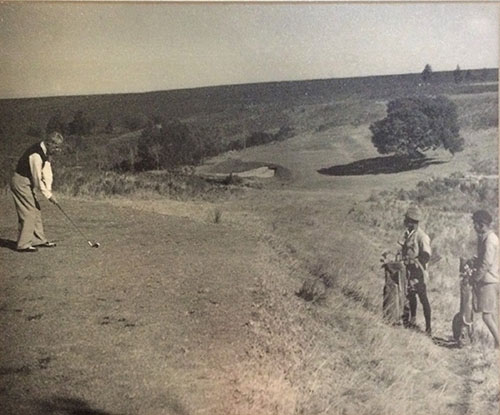
1886
It really started a hundred and twenty years ago. Laura Dumbleton, after visiting England in that year, not only brought home a husband for her sister, Cecil, but also managed to squeeze some clubs and balls into the “must take back to Africa” bag.
At Oakhurst (near Hoekwil) a three-hole course was quickly constructed and few visitors to the Dumbleton family escaped without first being initiated into the game being described, as legend has it, by the Chinese over 200 years ago, as the “torture of the thousand slices”.
On the farm, Lancewood some 10 miles away, Mr William Robertson soon followed suit and built his own three-hole course. No records exist to confirm whether reciprocity existed between the neighbours.
1890
A friend of the Dumbleton’s, the then manager of the Standard Bank, Mr Bairnsfather, saw the potential and with foresight and meticulous planning, known to his profession, he extended the game to be played alongside what is now the hospital road not far from the current greens and fairways. The golf course and not only the rough, consisted of unmanageable heather and the greens (sand) could not be protected from commonage cattle and the ever present donkeys.


1906
Despite the above mentioned handicaps, a golf club was formed in 1906 with the Honourable Mr Justice Graham as first president. Having moved around town in an effort to dodge the menacing heather, a nine-hole course was constructed on the original site some 10 years later and opened by the Mayor, HW Parsons, driving a ball off a 6-inch mud tree. During this period Bill Schreiner and Sport Pienaar of rugby fame, lost a golf bag in the heather and then proceeded to find a Kiewiet’s nest with two eggs in the cup on the green!
1930
Probably after several more Kiewiet episodes, Mr HJ Raubenheimer, was delegated with the task of constructing a proper 18-hole golf course. The well-known Mr CM Murray, from Wynberg, was the golf course architect, who should be credited to a large extent with the layout of the course as it is today.


1940
The Second World War brought a new class of membership to the George Golf Club. The 61st Squadron of the Royal Air Force, was stationed at George and all the officers, whether they played golf or not, became honorary members. They added to the spice and life at the club and provided one of the earliest aerial photographs of the course.
1950
A new clubhouse was built and almost immediately extended due to demand. A new era has started with the George Club, becoming more popular every year. In 1952, the British and Australian Amateur Women Golf teams visited George.
The British amateur team (men) played against South Western Districts on 6 February 1952.
During these years, the club had about sixty members with twenty-four on a Saturday, being considered a very crowded field! Entrance fee was two guineas and a new golf ball cost 1/6. Bobby Locke carded a gross 71 at George on 8 December 1954.


1960
The George Municipality approached the club with a request to move the 10th and 11th fairways to make room for a rugby stadium. This resulted in the course being extended to include the current holes, number 12 and 13.
1970
The Club’s strength and enthusiasm for the game was apparent when the Southern Cape Golf team won the South African Country Districts competition at Phalaborwa in 1971. Two of the members of that victorious team, Jack Parsons and John Mitchell, are still stalwarts of George today. During these years, George also hosted the South African interprovincial competition for the first time. The course was clearly fulfilling its potential as one of the great golf courses in South Africa.


1980
French and Spanish senior teams played at George extending its already growing international reputation as a wonderful golfing experience. A new club house was built and officially opened by Captain Dawie de Vries during 1983.
During this period, John Mitchell dominated the South Western Districts Open Amateur Championship (The Franklin Cup) winning it no less than seven times. Jack Parsons won the cup in 1961 and the great prospect, Louis Oosthuizen won in 2001 and 2002.
The local boys again showed their talent and commitment by winning the SA Country Districts Tournament in 1989 and again, most recently in Rustenburg in 2004 with no less than five members of the team of George.
1990
The nineties, as everywhere in the world, brought changes and the club was no exception. In 1993, the entire course layout was modernized by the construction of 18 new greens complexes, nine of them in totally new positions. Several new tees were built and the number of bunkers was increased from only nine to the existing thirty-three! The task was undertaken by Phillip Basson, Greenkeeper at the time, with input and assistance from (among others) Koos Sieberhagen (Captain 1997 & 1998), Club Pro, Vaughn Tucker and Dave Pirrie.
The only major structural change to the golf course was the installation of the dam in 1999. Remarkably, the course held its basic shape from 1937 to this day.


2000
The new millennium has confirmed the George Golf course as one that has withstood the test of time. Voted by Golf Digest as the ninth best course in the country (2004) and the 17th hole as one of the top 600 holes in the world (Golf Magazine 2000) the course provides a wonderful test of golf for all golfers!
The future promises more improvements; over the next three years, the committee is planning upgrading of tees and cart paths and the resurfacing of the greens. All the improvements are designed to keep George as one of the finest courses in South Africa!
Over the last three years, the clubhouse facilities have also been substantially revamped and improved.
